Menu
Kimball Elementary School Project
Kimball Elementary School is located in an underserved neighborhood one mile from the highly degraded Anacostia River. Kimball’s student and neighborhood populations face significant social challenges. It is located in one of DC’s poorest neighborhoods. Although the situation is difficult, Kimball’s highly dedicated staff and faculty have done a great deal to ensure that their students succeed academically and in life. We realized that by bringing our educational program to Kimball we would be able to support and enrich their academic program and have an opportunity to help restore the Anacostia River Watershed by creating conservation projects on the school property.
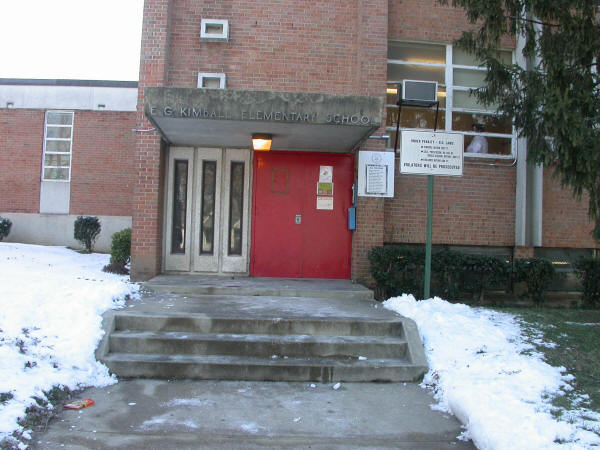
In 2004, LANDS and WATERS introduced the composting curriculum to Kimball's first grade students. Earth Sangha, a strong partner from the very beginning, provides plant, landscaping materials, and consultation for the conservation projects. Now in its sixth year, our environmental program reaches all grade levels. In 2008 Living Classrooms of the National Capital Region joined us in bringing hands-on education and conservation projects to Kimball. Let's take a look at some of the aspects of the Kimball Project.
Community Forest Park and Living Classroom
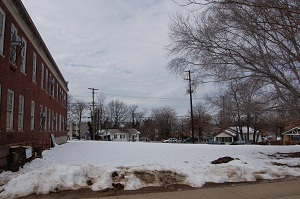
Turf grass filled to be converted into forest.
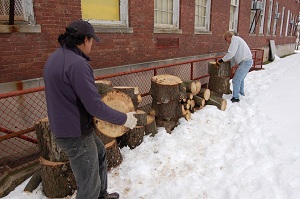
Volunteers bringing in logs to line mulched path. Logs taken from tree uprooted by recent snowstorm.
This year’s project: Creating a Community Forest Park and Living Classroom
This year we are focusing on is a prominently located, large (9500 s.f.) turf grass field adjacent to the school building. This area currently serves no environmental, educational, recreational, or community purpose. Our project, which we expect will take two to three years to complete, will convert this unused space into an outdoor classroom, wildlife habitat, and community park. Project components include creating a mulched path that will meander through the area and connect the front and back of the school grounds, build benches to accommodate one class, provide park benches for the community, plant native plant communities representative of an upland forest, and provide educational signs explaining the importance of forest habitats and living classrooms.
Cinder Block Garden
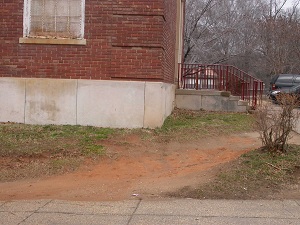
Eroded area used as a shortcut.
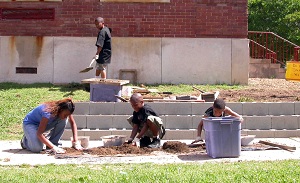
Students amending and filling cinder blocks with soil for planting.
The above picture clearly demonstrates the damage foot traffic can do to an area. For many years, this area was used as a short cut to the school cafeteria. Over time foot traffic caused a deep gully to form and prevented any vegetation (even turf grass) from surviving on the slope. Erosion was a constant problem. The eroded soil washed into a storm drain located close to the area. Lands and Waters wanted to correct this problem with a project that would not only address erosion but would also expand planting opportunities for students.
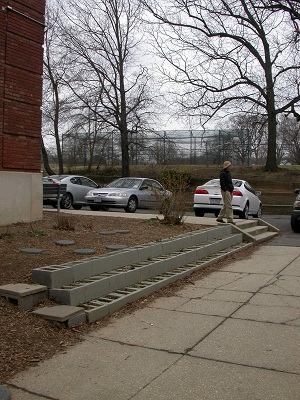
Completed cinder block terrace garden.
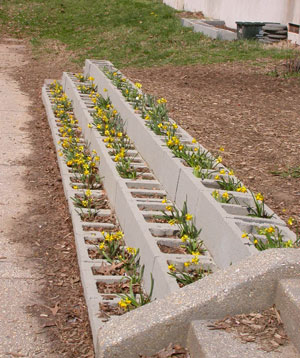
Spring bulbs begin to show.
A cinder block terraced garden was created. As each lower level was created, it was backfilled with amended soil and another cinder block wall was put into place. The holes in the blocks serve as planting pots for bulbs as the hands-on component to a lesson on plant reproduction.
Vegetable Garden
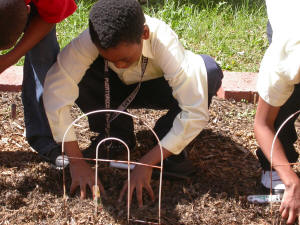
Students planting seeds.
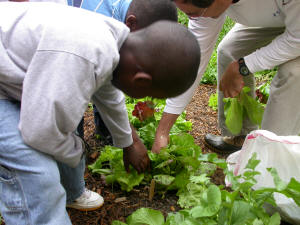
Students harvesting vegetables.
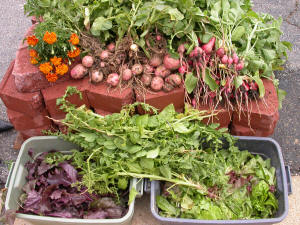
Harvest at the end of the year.
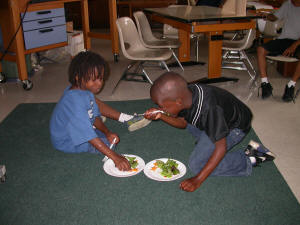
Students eating salad from the garden.
We have found that both urban and suburban students have little or no understanding of food production much less the opportunity to grow their own food. Now each year every student at Kimball participates in the planting, harvesting, and eating of vegetables from their own garden. Planting begins in early spring. It is a magical moment when the vegetables begin to appear in the garden. Students are amazed to realize that those tiny seeds they spread upon their own one foot square plot would eventually grow into plants abundant enough to feed everyone at Kimball. We're amazed, too!
Green Roof Art Kiosk
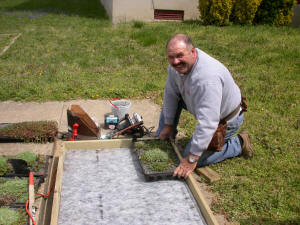
Placing the vegetated trays on the roof membrane.
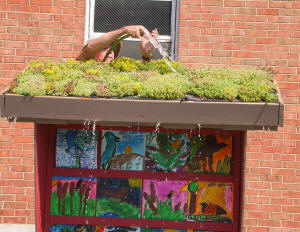
Volunteer watering the roof during the establishment phase.
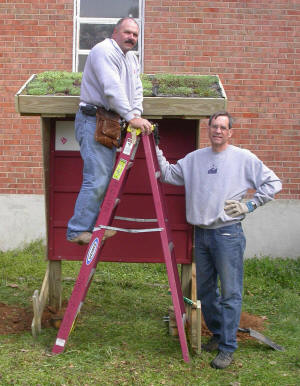
Putting the final touches on the kiosk.
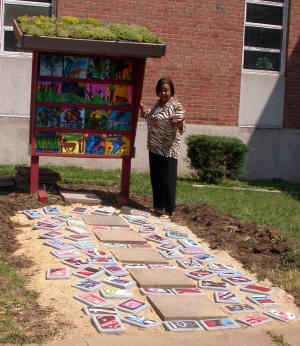
Kimball's principal admiring student's artwork.
The reduction of stormwater runoff is of particular importance in the Anacostia Watershed because DC has a combined sewer system. In a heavy rainstorm, the older sanitary sewers overflow and their untreated contents flow directly into the river. It is estimated that more than two billion gallons of raw sewage are discharged into the Potomac and Anacostia Rivers every year. Through our program, students learn about Low Impact Development Techniques. One very effective way to reduce stormwater runoff is to turn impervious roof tops into pervious surfaces capable of retaining up to 80% of the water that falls on them through green roof technology.
To illustrate this technique, Lands and Waters partnered with Michael Perry of Building Logics to build a kiosk to house students' art work of the Chesapeake Bay Watershed. Mr. Perry provided design and materials and built the kiosk for the school. Third grade students provide the art work which is rotated through out the year to ensure each painting is displayed.
Stepping Stone Art
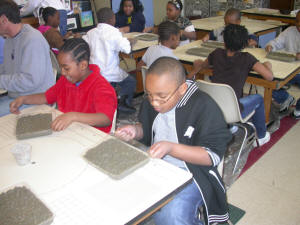
Students vibrating the concrete to remove air bubbles.
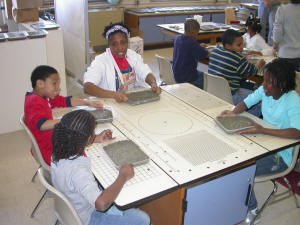
Students working with art teacher.
Our environmental program integrates easily with art. The stepping stone project is a combination of lessons on pollination and the creation of stepping stones decorated with the color patterns of pollinators. The students make the blocks from concrete poured into salad containers. After pouring, students remove the air from the concrete by the vibrating the molds by hand. It's a hard task and students get pretty tired before the work is done, but the stones turn out beautifully! They take a few weeks to dry and then the painting begins. Stepping stones are used to line paths in the gardens and kiosk area.
Meadow and Forest Garden
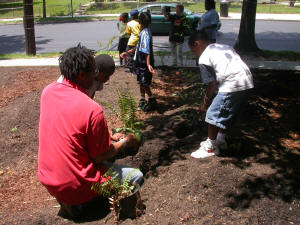
Planting understory plants for the forest garden.
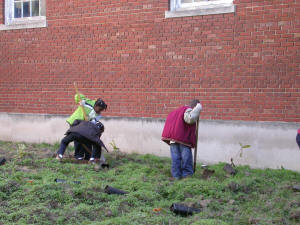
Planting in the pollinator garden.
As we teach about the benefits of meadows and forests, we emphasis their value for wildlife habitat and the alarming rate wildlife habitat is being destroyed. Once students understand a problem, they immediately want to find ways to help solve it. Our conservation projects grow from what we observe to be a natural desire on our students' part to protect and conserve the natural world. Two conservation projects are on-going at Kimball, a pollinator garden hosting meadow plants and a forest garden hosting plants typically found in a forest. Only native plants are used in our conservation project.
Anacostia Watershed Walk
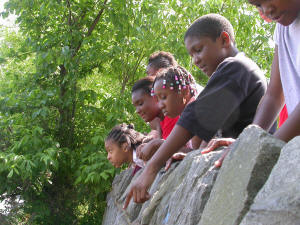
Students look out over the local stream and share their observations.
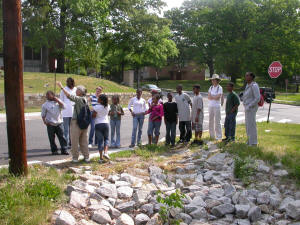
Examining the forebay of the local raingarden.
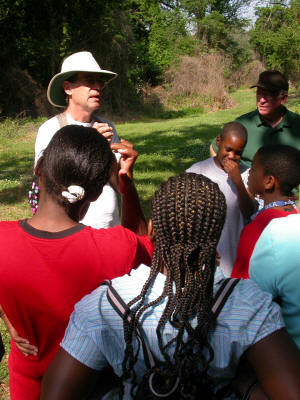
Volunteer explaining invasive plants.

Students and Jeanette observe the point where the local stream is channeled into a stormwater pipe.
Students graduate from Kimball at the end of the fifth grade. To celebrate their graduation and their completion of our environmental program, fifth grade students take a walking tour of their watershed by following a local stream to the Anacostia River. Along the way, students, teachers, and volunteers discuss their observations. There's a lot to see - trash and sediment pollution, invasive plants, wildlife, and even a new rain garden to control water runoff before it enters the stream. For us, this is a very rewarding activity because we are able to see how our students have begun to see their neighborhood from a watershed point of view. They are seeing, often for the first time, just how human development and behavior impact the natural world. The conservation projects they have participated in give them the tools to become what we hope will be lifetime stewards of the natural world.
